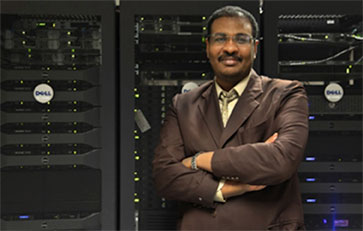Posted 12:59 p.m. Friday, Jan. 24, 2014

The need for faster 24-hour network access by students, faculty and staff has prompted UW-L to make strategic investments to ensure the academic mission is being met.
 UW-L Chief Information Officer Mohamed Elhindi[/caption]
As use of technology grows in personal and academic lives, so does an insatiable appetite for speed to access data and information anytime, everywhere, worldwide. Along with “need for speed” is an ever- growing consumption of larger and more complex data files, HD video, multimedia, social media and gaming. Unseen by the users is a vast collection of fiber, switches, routers, and servers that allows the data to move fast. The more data used, the more it is craved. It’s a never-ending cycle.
The need for faster 24-hour network access by students, faculty and staff has prompted UW-L to make strategic investments to ensure the academic mission is being met, says Mohamed Elhindi, chief information officer. Since 2011, the campus has migrated from a 300MB network to a 10G network.
To the put this bandwidth increase in perspective, consider walking at an average three miles per hour. The magnitude of the increase of network speed on campus would translate into walking more than 30 miles per hour. Blazing a new trail for fast and consistent network connectivity has become a necessity and priority.
“The past few years have been marked by unprecedented innovation and growth on the Internet,” notes Elhindi,. “New digital platforms and rich content, from high quality video streams facilitate online learning and digital education require fast connectivity. New applications allow for the creation and sharing of original content and ideas through cloud based computing.”
UW-L Chief Information Officer Mohamed Elhindi[/caption]
As use of technology grows in personal and academic lives, so does an insatiable appetite for speed to access data and information anytime, everywhere, worldwide. Along with “need for speed” is an ever- growing consumption of larger and more complex data files, HD video, multimedia, social media and gaming. Unseen by the users is a vast collection of fiber, switches, routers, and servers that allows the data to move fast. The more data used, the more it is craved. It’s a never-ending cycle.
The need for faster 24-hour network access by students, faculty and staff has prompted UW-L to make strategic investments to ensure the academic mission is being met, says Mohamed Elhindi, chief information officer. Since 2011, the campus has migrated from a 300MB network to a 10G network.
To the put this bandwidth increase in perspective, consider walking at an average three miles per hour. The magnitude of the increase of network speed on campus would translate into walking more than 30 miles per hour. Blazing a new trail for fast and consistent network connectivity has become a necessity and priority.
“The past few years have been marked by unprecedented innovation and growth on the Internet,” notes Elhindi,. “New digital platforms and rich content, from high quality video streams facilitate online learning and digital education require fast connectivity. New applications allow for the creation and sharing of original content and ideas through cloud based computing.”
 As more electronic devices are introduced, demands on network speed and bandwidth continue to grow. “The increase in devices accessing the Internet, such as smartphones, laptops and iPad puts a strain on Internet bandwidth, which is the measure of how fast bits of data can transfer within a given time period,” explains Elhindi. “More devices accessing the Internet generally translates into slower connections and longer waits for students to download data and Web pages. New educational services and applications will require more data which creates a need for us to increase our bandwidth capacity.”
EDUCAUSE, a nonprofit worldwide association of IT leaders and professionals committed to advancing higher education, lists the top IT issues that are priorities for academic institutions. In 2013, the top 5 priorities included: Access demand, Improving student outcomes, Cloud strategy, Consummerization and BYOD.
Each has an important impact upon the ability to provide robust and solid network infrastructure and speed, says Elhindi. “This increase in bandwidth has been caused by the increased use of smartphones, greater use of streaming video, the transition to the Google cloud email system and other hosted services, particularly at the peak hours” he says.
[caption id="attachment_30243" align="alignright" width="150"]
As more electronic devices are introduced, demands on network speed and bandwidth continue to grow. “The increase in devices accessing the Internet, such as smartphones, laptops and iPad puts a strain on Internet bandwidth, which is the measure of how fast bits of data can transfer within a given time period,” explains Elhindi. “More devices accessing the Internet generally translates into slower connections and longer waits for students to download data and Web pages. New educational services and applications will require more data which creates a need for us to increase our bandwidth capacity.”
EDUCAUSE, a nonprofit worldwide association of IT leaders and professionals committed to advancing higher education, lists the top IT issues that are priorities for academic institutions. In 2013, the top 5 priorities included: Access demand, Improving student outcomes, Cloud strategy, Consummerization and BYOD.
Each has an important impact upon the ability to provide robust and solid network infrastructure and speed, says Elhindi. “This increase in bandwidth has been caused by the increased use of smartphones, greater use of streaming video, the transition to the Google cloud email system and other hosted services, particularly at the peak hours” he says.
[caption id="attachment_30243" align="alignright" width="150"] UW-L Information Technology Director Jim Jorstad[/caption]
The increase in network capability will provide great dividends in and out of the classroom, says Jim Jorstad, IT director. “Robust and fast network infrastructure will create virtual academic environments for students and faculty to communicate through learning management systems, HD video conferencing, Web streaming, and a wide palette to digital learning and teaching tools,” he notes. “In this environment, both your personal and academic worlds can become seamless in a millisecond.”
For almost every academic institution, having a strong and solid core network infrastructure will be essential. With more than 2.4 billion Internet users worldwide, being connected across global will continue to be extremely important.
“The world led primarily by email traffic has been supplanted with an environment of 500 million photos unloaded daily and 100 hours of video uploaded every minute,” says Jorstad. “In this new high speed data environment, your personal and academic world is increasingly becoming essentially seamless, with almost instant access to each.”
High-speed bandwidth is what makes this all possible. “This level of connectivity is necessary to allow both students and faculty to use new and future Web technologies to teach and learn,” says Elhindi. “To be prepared today and in the near future, having robust network capacity and speed will be essential.”
UW-L Information Technology Director Jim Jorstad[/caption]
The increase in network capability will provide great dividends in and out of the classroom, says Jim Jorstad, IT director. “Robust and fast network infrastructure will create virtual academic environments for students and faculty to communicate through learning management systems, HD video conferencing, Web streaming, and a wide palette to digital learning and teaching tools,” he notes. “In this environment, both your personal and academic worlds can become seamless in a millisecond.”
For almost every academic institution, having a strong and solid core network infrastructure will be essential. With more than 2.4 billion Internet users worldwide, being connected across global will continue to be extremely important.
“The world led primarily by email traffic has been supplanted with an environment of 500 million photos unloaded daily and 100 hours of video uploaded every minute,” says Jorstad. “In this new high speed data environment, your personal and academic world is increasingly becoming essentially seamless, with almost instant access to each.”
High-speed bandwidth is what makes this all possible. “This level of connectivity is necessary to allow both students and faculty to use new and future Web technologies to teach and learn,” says Elhindi. “To be prepared today and in the near future, having robust network capacity and speed will be essential.”
